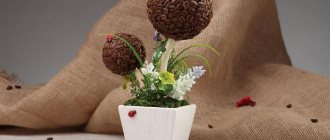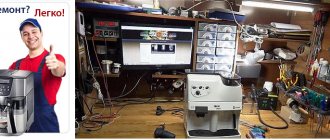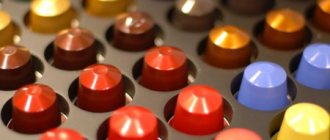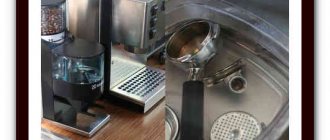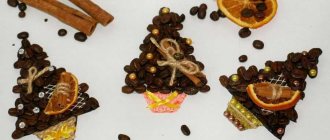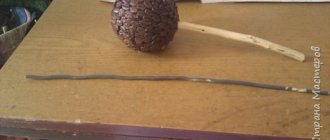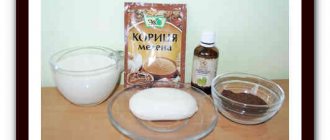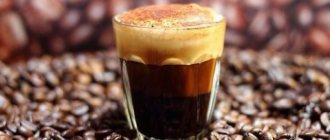Espresso... It would seem like strong, black coffee, what difficulties could there be? But they exist, and preparing this drink correctly is not so easy, even using modern technology. Whatever the coffee machine, it will not be able to brew coffee without your participation.
It is important to set up the equipment correctly, keep it clean and follow the operating rules. Another important factor is the choice of raw materials, adherence to dosage and accuracy in preparation time. Now let's talk about everything in order.
Setting up the coffee machine
This is an important preparatory step on the way to the perfect espresso. To keep your equipment running like a clock, follow a few simple rules:
- Before starting work, clean all containers from dust;
- connect the device to power and water supplies (water supply is not required for all models);
- turn on the device;
- fill the reservoir with cold water;
- set the desired heating level;
- when the water reaches the desired temperature, drain it;
- set the volume of liquid per serving and the water hardness level;
- if there is a grinding function, adjust the coffee powder fraction;
- set the volume of one serving of the finished product;
- start the cooking program.
Coffee as a science: the perfect espresso with your own hands
If
If you love espresso and want to prepare it according to all the rules, read our new article. In it, we tried to describe all the subtleties and features of preparing real espresso, and also analyzed possible mistakes so that you can avoid them in the future.
Before you start preparing your magical invigorating drink, make sure you take into account all the necessary “variables” that affect the final result. Some of them are important when brewing any type of coffee, while others are unique and important exclusively for espresso. Let's list them just in case.
Water
The taste of your espresso directly depends on what kind of water you use. Sediment, suspension, salts, and other undesirable components can irreversibly damage not only coffee, but also expensive equipment. For this reason, if you are not sure of the quality of the water from your tap, use bottled drinking water or pass the water through a regular household filter (charcoal, reverse osmosis, pitcher filter, etc.).
Grinding
Espresso requires a finer grind than other coffee brewing methods. Properly ground coffee beans should resemble fine salt. If your coffee maker doesn't have an automatic grind setting, you'll know you've reached the desired grind level when the ground coffee particles begin to clump together. Try and experiment to finally get the desired result.
A portion
For a standard double espresso shot (double shot), we recommend using 18 to 21 grams of ground coffee. The more coffee you take, the richer and denser your drink will be. Adjust the serving size depending on your personal preferences.
Tempering
Forming a “coffee tablet” or coffee bookmark is an important step in making espresso. Their interaction with water, and therefore the correct extraction of coffee, depends on how well and evenly the coffee particles are compacted. Experienced baristas compact coffee with a force of 13-15 kilograms. You can understand what kind of effort this is, and at the same time practice, on ordinary floor scales. Do not forget to ensure that the edges of the “tablet” are strictly horizontal, without distortions.
Temperature
The water temperature for preparing espresso should be 90-96°C. Some coffee machines allow you to control the water temperature, if so, experiment. You'll notice that lower temperatures help bring out the bright notes, while higher temperatures add bitterness, but too low a temperature will cause the coffee to sour.
Beverage output
Espresso loves extreme precision in measurements. If to prepare brewed coffee it is enough to know the ratio of water and ground coffee, then when preparing espresso, we operate with the concepts of “coffee dose” and “drink yield.” If the dose can vary within small limits, then the yield of classic espresso per serving is 30 ml. That is, you should prepare dishes based on this volume.
Time
With a recommended dose of 18-21 g. coffee and the drink yields 30 ml between the start of brewing and the moment when the cup is filled, 25-30 seconds should pass.
Just half a minute to enjoy your favorite coffee? Not bad at all!
TOOLS:
Coffee machine
An ideal coffee machine has durable, reliable parts, a stable water heating temperature, and convenient and intuitive controls.
Coffee grinder
Consistently delicious espresso is the result of uniformly ground coffee beans. When choosing between a burr grinder and a blade grinder, choose the first one. It allows you to fine-tune the grind size and grinds the beans evenly, just like you want for espresso.
Filter (holder)
For beginners, we recommend getting a bottomless portafilter or a holder with two water cans and a double basket, this is probably the largest basket that comes with your coffee machine.
Temper
To form a high-quality coffee tablet, the tamper must fit tightly to the edges of the basket. Most baskets have a diameter of 58mm. In our store catalog you will find a large selection of tampers of different sizes.
Scales
One of the barista's most essential tools. Rest assured, you will need scales both when you are just at the beginning of searching for your own taste preferences, and later, when you gain experience and confidence for new, bold experiments. For greater accuracy, choose scales with minimal steps.
So, we come to the main part of our instructions. We have all the necessary equipment, we stocked up on water and excellent quality coffee beans. We can get started!
HOW TO PREPARE ESPRESSO?
- Fill the coffee machine reservoir with water to the required level. Make sure the water is cold, filtered, and not too soft or hard. We remind you once again that water quality is one of the key elements when brewing espresso.
- Turn on the coffee machine and give it time to warm up. Depending on the model, this may take from 15 to 45 minutes. Perhaps there is no need to rush even when the desired temperature is reached. Wait a little longer for the coffee machine to warm up thoroughly.
- Insert the empty portafilter into the group head and run the machine for a few seconds. This will allow fresh water to flow into the cone and warm up the parts of the machine that come into contact with the coffee. Thoroughly dry the portafilter and the bottom of the group with a towel.
- Grind a few coffee beans to ensure the grind size is correct. The coffee should be ground finely and uniformly, resembling fine salt in appearance. Take a pinch of coffee and rub it between your fingers. You should feel the roughness. If so, you are on the right track. Fill the portafilter with 18-21 grams of ground coffee, rotating the portafilter slightly to distribute the coffee evenly. Smooth out the coffee using your fingers.
- Take the tamper and place it in the portafilter. Place your wrist, forearm and elbow over the center of the portafilter. When forming a coffee bookmark, try to press evenly. The correct coffee “tablet” does not fall out if you turn the holder over, and after brewing it has the consistency of plasticine and is easily removed from the basket.
- Insert the portafilter into the group head and start making espresso. If your coffee machine has a "pre-infusion" or "pre-infusion" function, turn it on. Pre-wetting the tablet will help remove carbon dioxide, which inhibits the extraction of flavors. Pre-wetting is not a necessary step, so try which brewing option you like best: with or without wetting.
- Turn on the hot water supply and monitor the cooking. In 27-30 seconds you should have a double espresso with a yield of 30 ml.
POSSIBLE MISTAKES:
A lot of time passed between starting the coffee machine and the drink appearing from the filter (more than 30 seconds). As a result, the espresso may taste bitter. To fix this,
- Use less coffee OR
- Use a coarser grind OR
- Temper with less force.
Too little time has elapsed from starting the machine until the drink appears from the filter (less than 25 seconds). The result was a weak and watery espresso. To fix this,
- Use more coffee OR
- Use a finer grind OR
- Temper with great force.
Espresso has a sour taste. You may have stopped the chemical reaction between water and coffee too early.
- Increase water temperature OR
- Increase cooking time
Espresso tastes strange. Sometimes water passes through the coffee bean unevenly, and extraction is disrupted. To fix this,
- Examine the coffee tablet to see if there are any channels, cracks or holes in it, THEN
- The next time you brew, make sure you distribute the coffee evenly AND
- Check your effort when tempering.
The espresso turned out watery. The espresso should be full-bodied and thick. To achieve this, you should choose the optimal ratio of coffee yield and brewing time, and also use fresh, high-quality coffee. So:
- Reduce the amount of water OR
- Use more coffee OR
- Use a finer grind OR
- Temper with more force
The stream of drink from the holder flows unevenly. On its way from the horn to the cup, the water chooses the path of least resistance. If the coffee bed is not compacted correctly or has cavities, then water will pass unevenly through the coffee, extraction will be disrupted, and, accordingly, the taste of the coffee will deteriorate. To avoid this,
- Make sure you distribute the coffee evenly AND
- Check your effort when tempering.
There is too little crema in the espresso.
- Use more coffee OR
- Use a finer grind OR
- Check the freshness of your coffee.
There is too much crema in the espresso. Don't be surprised, this happens. Coffee beans that contain a large amount of gas immediately after roasting are not ready to be used for making espresso, as they produce a lot of foam.
- Give the coffee beans a couple of days to rest.
We hope these simple tips will help you find your balance in making the perfect espresso!
Selecting raw materials
Choosing the right bean is the key to success in making delicious espresso. For the classic version of this drink, use the Arabica variety or a mixture of Arabica and Robusta. In the first case, the taste of the finished product will be soft, in the second - tart, with bitterness. Roasting grain should be dark. The type of roasting for espresso is also called “Italian” - this grain is very dark, almost black. At the same time, beans from coffee blends that contain Robusta should be slightly lighter.
Dark roast beans are used exclusively for coffee machines. Baristas do this so that the taste of the coffee acquires a sweetish, rich hue. Light grains can produce excess acidity and wateriness.
Increasing extraction
We prepared espresso with an optimal Brew ratio of 1:2 (18 grams of ground coffee - 36 grams of espresso), falling within the recommended extraction level of 18%, but the taste is dominated by a herbaceous taste, low sweetness and sharp, unpleasant acidity, i.e. espresso is under-extracted.
To increase extraction, we need to reduce the amount of coffee, reduce the grind, or increase the water temperature. By reducing the mass of ground coffee and increasing the area of contact between coffee and water (reducing the grind), we increase extraction.
Making classic espresso
There are several factors to consider when preparing this type of coffee. And each barista, after many years of experience, comes to his own, individual technology: some use longer extraction, others experiment with roasting and the type of raw material. But in any case, they all rely on the classic recipe, which contains the basics of making the perfect espresso:
- The extraction lasts 25 seconds. Until you learn how to make espresso with your eyes closed, stick to this interval;
- The amount of ground coffee depends on your portafilter basket. Typically, one standard serving requires 7-10 grams, for a double serving - 16-20 grams;
- The volume of one serving of the finished product is 25-35 ml;
HELP: The amount of water when preparing espresso in a coffee machine does not matter.
A few more important parameters, the observance of which will lead you to the pinnacle of mastery:
- Water pressure. The optimal working pressure is considered to be 8.2-9 atmospheres. To adjust it, prepare a tablet, insert it into the holder and turn on the flow. Pay attention to the monometer and adjust the desired value. During further use, also periodically monitor the numbers on the scale.
- Water temperature . Espresso beans are roasted to a specific temperature, and it is best to adhere to this value. 93 degrees is considered optimal. If the model of your coffee machine does not provide for setting the temperature with an accuracy of a degree, and the adjustment is made with a bolt on the pressure switch, be guided by experience based on the taste of the finished product. Too acidic - we increase the temperature, sharply bitter - we lower it.
- Coffee dosage and portafilter volume . When choosing a basket, give preference to a double one. The extraction is more stable in them. The double basket contains from 16 to 21 grams. ground coffee, depending on its volume. Usually the dosage is indicated on the basket itself and must be strictly followed. If you decide to make a drink from 16 grams of coffee in a basket designed for 21 grams, you will not be happy with the result. If there is no marking, then be guided by the size of the coffee tablet: it should not reach the dispersion mesh slightly.
- Tempering . When making espresso, it is important that the water flows evenly through the entire coffee tablet. To do this, the tablet must be equally dense throughout its entire volume, without lumps, inclusions or voids. Distribute the coffee evenly in the basket and tamp it down with a tamper, avoiding distortion of the tablet. Choose a tamper with a flat base and a diameter close to the size of the basket.
- Extraction . Before installing the holder into the coffee machine, pour 50-100 ml. water. In units with a heat exchanger, this is done in order to reduce the temperature, and in double-boiler units, this is done to clean the mesh from the remnants of previous cooking. Now install the holder and start cooking. The quality standard is considered to be an espresso weighing 36 grams, prepared from 18 grams of ground beans, in 27 seconds at a temperature of 93 degrees. These parameters can be changed depending on the characteristics of a particular coffee machine. IMPORTANT: As soon as you have installed the holder, immediately turn on the pour; a pause at this stage will distort the taste of the finished product, and most likely not for the better.
- Adjusting the taste. Have you prepared espresso following all the recommendations, but its taste is not perfect? There are several ways to correct the situation:
- If the coffee is too sour, increase the yield of the finished drink, increase the temperature or extraction time;
- If there is a lot of bitterness, reduce the yield, reduce the temperature or extraction time.
IMPORTANT: When adjusting the flavor, only change one parameter at a time, otherwise you may overdo it and then have to go back to square one and start over.
How to set up espresso. Part 1.
Today we will begin a series of articles about setting up espresso.
The first part will be very primitive, but important, because... For most establishments, even such banal things as the presence of scales are something incredible.
Let's imagine that a person does not know how to brew coffee at all, but he needs to brew it, there are different situations. And let’s discuss in advance that this situation is hypothetical, and in real life only a barista who has undergone appropriate training should brew coffee.
This article is an instruction on how to brew acceptable coffee if no one knows how to brew it. Instructions for dummies.
The first thing I would like to say and what both baristas and establishment owners should accept is that the espresso needs to be adjusted and constantly ensure that it does not change. Never in your practice will there be a situation where you set up coffee once a month, week, day... and do nothing else. Coffee is constantly changing and needs to be monitored.
The 90s are long gone when a technician (a guy with a mustache) came to a restaurant once a month, or even less often, to change something and strictly forbade touching the equipment.
Now the barista must use all the tools that the equipment provides. And he must use this functionality consciously and skillfully!
Now let's get back to the instructions for dummies.
First, let’s briefly go over what is needed to have decent coffee in a coffee shop/bar/restaurant. An important note – normal! This is the lowest standard of coffee that can be given to a guest.
- Adequate coffee machine
- Decent coffee grinder
- Good coffee
- Coffee scales (preferably 2-3 pcs.)
- Timer (if not built into the machine and it is not included in the scales)
- Good tempera
- Good pitchers of different sizes (3-4 pieces minimum)
We’ll leave everything related to milk for later, and now let’s just talk about espresso.
The first and most important thing that must be behind the bar is a coffee scale. If you don’t have them, you need to purchase them urgently; without them, it is not possible to brew coffee that can be given to a guest. Dot.
The first thing we will do is to weigh each time how much dry coffee we grind, note the time and monitor the weight of the finished drink (using scales and a timer!) This is extremely important, you cannot weigh it once every 5 preparations, once a day, etc. options . Strictly every time.
There are times when you come to the bar and ask: “Guys, where are your scales?” - Yes, right there, in the bottom drawer.
The scale shouldn't just be behind the bar, it should be in the workplace, turned on and used for its intended purpose every time a cup of coffee is brewed.
- But why weigh it, you can set it in a coffee grinder... ???
- But why, in a coffee grinder you can ask... ??? - No!
If you have a coffee grinder that accurately produces a given weight, then with a high probability you haven’t read this far) We laughed somewhere at the beginning and went to look for more in-depth articles about coffee extraction. You just don't need this article)
With rare exceptions, coffee grinders grind according to time; they do not track how much coffee has been poured into the holder. The task of the coffee grinder is to turn on the engine for xx.xxx seconds. and that's all. How much coffee gets into the coffee grinder holder during this time is not particularly interesting. And for us, to prepare the drink, the weight of dry coffee (dose) is critically important. Changing the dose by 0.5 g will give a noticeable change in taste.
In addition, coffee is very sensitive to its environment and can change its density throughout the day, and all beans vary slightly in size and density. Because of this, at the same time, each time a different number of grams will be ground. coffee.
It is critical always weigh the dose.
We've sorted it out. It is critical always weigh the dose. If you decide to do it by eye, it’s better not to brew coffee at all! It is much better if the establishment has no coffee at all, and there are many examples of this.
With the introductory part done, let's get to the espresso!
We will brew according to brew ratio (BRT – the ratio of the weight of the finished coffee to the weight of the dry coffee). BRT=double espresso weight/dose
This parameter shows how dense (concentrated) the drink will be: the lower this value, the closer to ristretto our espresso will be, the higher it is, the more “lunged” the coffee we will get. The average BRT = 2, this value was obtained empirically, and we will rely on it.
The next parameter is the dose.
Choosing the right dose depends on many variables, but since these are instructions for emergency situations, we will choose a dose equal to 18 g. In future articles we will look at what you should pay attention to when choosing a dose, for now we will sacrifice this espresso setting parameter.
Why exactly 18 gr.? Because most of the meshes in holders are designed for just 18 g. We will not consider meshes for 20 g or more; the probability that a mesh larger than 18 g came with the car in stock tends to zero.
At 7, we immediately remove the grids as far as possible and forget about their existence; it is impossible to brew adequate coffee from it in the case when the barista does not know how to brew, or is in the learning stage. If the barista knows how to brew something adequate in a 7 g mesh, he will explain why this mesh should be immediately removed and forgotten about)
We decided: BRT=2 Dose=18g.
Accordingly, the weight of a double espresso (hereinafter, for convenience, just espresso) should be 18 * 2 = 36 g.
But we have one more very important parameter - this is the extraction time (this is what we will call the time from turning on the group to turning it off in seconds). The choice of extraction time is as important a parameter as the choice of dose, but now let’s simplify the problem as much as possible and take average value is 25 sec. In practice, the extraction time, as well as the dose, is selected based on many parameters, as well as temperature, and what’s more, pressure. We will definitely talk about all this in future articles.
What we have? Dose = 18g. Espresso weight 36g. Extraction time 25 sec. And as a consequence BRT=2
All that remains is to decide on the grinding. Most people who encounter coffee believe that grinding is the most important thing and frantically turn the handle (disc) back and forth, completely not paying attention to the dose, the weight of the espresso, or the extraction time. So how do you choose the right grind for espresso?
How to choose an espresso grind?
In fact, we have already set the desired grind in the previous steps. Now all that remains is to set the desired grind value on the coffee grinder so that it corresponds to the values set above (dose, extraction time and espresso weight (hereinafter we will call these all settings)).
How to do this? It's actually quite simple. Having set ourselves the necessary settings, we set the parameters of the coffee grinder. This means that we will not be able to cook 36 grams with the wrong grind. espresso from 18 gr. grains in 25 seconds (our settings).
Having set the settings, we simply follow the algorithm and thereby set the correct grind on the coffee grinder.
- We fill the cup on the scales and place it under the group.
- Pour 18 g of coffee into the holder (by scale! ), try to distribute the ground coffee as evenly as possible throughout the entire volume of the mesh (we’ll also talk about distribution separately)
- We temper with a force of approximately 10 kg (the skill will have to be developed by training with large weights)
- Under no circumstances should we tap the tamper on the holder; at most, you can carefully shake off the coffee dust from the sides of the mesh so that it does not erase the gum in the group.
- Carefully insert the holder into the group without any sudden movements or impacts.
- We turn on the spill and at the same time turn on the stopwatch.
- We wait exactly 25 seconds and at 25 seconds we turn off the flow.
- Let's see how much weight we have in the cup.
- If there is 36 g in a cup - perfect! You have successfully set up your espresso. You can try it, and if you don’t know what to do next with it, but you need to give away the coffee, then you can stop at this stage. At the same time, you understand that you are giving your guests a drink brewed at 3 minus.
- If there is more than 36g in the cup, then we reduce the grinding on the coffee grinder (most often indicated by the word FINE). This must be done strictly on working millstones, otherwise the coffee grinder may jam if there is less than 36g in the cup, then we increase the grinding (usually indicated by the word GROAS)
- After changing the grind, it is necessary to grind 15-30 g of coffee so that the remaining coffee from the previous grind comes out of the coffee grinder. Use a special glass for this. This coffee (resin) can be used in the kitchen to decorate desserts, or in the morning to boil the car. Guests are not allowed to cook smol.
- Let's repeat it all over again
- We do this until we have 36 g of espresso in 25 seconds from 18 g. ground coffee.
Settings – a specified set of coffee parameters. Dose, weight of espresso, extraction time. Next, we will add temperature, tempering, pressure curve in the group, etc., but the main ones are the first three.
Half the job is done, we have set up the “technical” espresso. This drink is a half-measure, but, unfortunately, even this is not brewed in a huge number of establishments. Most often they simply pour it by eye, temper it anyhow, and pour it until as much as is needed, also by eye. Covering up your inability to cook with a bunch of excuses.
Should I weigh it every time? Yes, my bar will work like that!
There can be any excuses and as many as you like, but delicious coffee will only come with good equipment, grain and a diligent attitude to work.
Is it possible to cook delicious food with poor equipment? Yes, but it's very difficult and not worth it. The barista will quickly get tired of dancing with tambourines, and he will leave.
Is it possible to brew delicious coffee from bad beans? No. Here, even the most experienced and positive-minded barista will quickly give up this idea. But you shouldn’t give in to the easy way of calling any coffee bad. Very often the barista is lazy to think and adjust, blaming the roaster: “They roasted poorly again.”
Now we have set up our “technical” espresso, what next? And then the most difficult thing: firstly, you need to make sure that each subsequent cup meets these parameters. To do this, you need to weigh and time each cup. And, if something goes wrong, immediately adjust the settings (in our case, grinding according to the scheme described above).
The next step is to try the coffee you brew and compare it with what you can taste in good coffee shops and try to understand what is different.
Here is an article on how to start understanding tastes.
- It's long and inconvenient! - Yes, if I weigh everything, I will never give orders - I have nothing else to do? — and I’m not a barista at all! ...
Once again, there can be any number of excuses, but if you want to brew good coffee, then you will have to weigh each cup, and nothing else.
In a good way, the first step is to go to the place where a good trainer will teach you how to set up espresso, he will put his hand on it, tell you about the tastes and all the parameters of the equipment with which you will work.
Above is a cheat sheet for a hopeless situation or “how to brew espresso for dummies”
In the future, we’ll look at what other parameters there are and how they affect the taste of coffee.
Espresso, how to set up espresso, setting up espresso
25.04.2121
Several recipes
Espresso is not only an independent drink with a viscous texture and rich taste. It is also the basis for making many coffee cocktails. In this case, how tasty your cocktail will be directly depends on a well-prepared espresso. Let's prepare the classic and double versions step by step.
For you:
Ice Latte is the best refreshing solution on hot days
Classical:
- Measure out 7-10 grams of ground coffee.
- Pour into the holder and tamp down.
- Turn on espresso mode.
- The coffee will be ready in 30 seconds.
IMPORTANT: The espresso cup must be hot. Most modern units heat dishes depending on the selected program. If your coffee machine does not have this function, pour boiling water over the cup before starting to brew.
Doppio (double):
Doppio is essentially just a double portion. Therefore, the cooking process does not differ from the classic recipe, but we increase the amount of grain in accordance with the volume of the basket. Usually it is 16-20 gr.
Time is the last step towards our perfect espresso. It is measured in seconds, starting from the moment the water starts and ending when you stop the process. Time is the least important variable in any espresso recipe, but it can still make the espresso better or worse. You can have a 20g dose and 50g output, but if it comes out in 10 seconds, your espresso probably won't be good. Contact time is important to extract the aroma and bring out the sweetness and versatility of the coffee.
Most espresso brewed in modern cafes will have an extraction time between 25 and 32 seconds.
“Fast espressos” are usually light in body and high in acidity. Slow Espressos tend to have a heavier body and a pleasant sweetness on the palate. If the time is too fast, the espresso will be thin, weak and sour. If the time is too long, the espresso will be bitter and strong. This is not a hard and fast rule, but will certainly apply to most coffees.
Let's say your ideal recipe is a 20g dose, 40g extraction and 30 seconds.
To make this espresso, you would use a 20g dose, achieving a yield of 40g in 30 seconds. Please note that the quantity of the finished drink is not negotiable, unlike the time.
There are three main factors that influence the extraction time.
1. Grind size
Imagine two pipes. One is full of stones and the other is sand. Now imagine that you are pumping water through pipes.
The rocks will obviously carry water much faster than sand.
It's the same effect. The finer the grind, the slower the flow. The larger the size, the faster.
This setting can be done with almost every grinder, giving you the freedom to choose the amount of time it takes to achieve the desired result.
2. Pressure
Most coffee machines have a pressure of approximately 9 bar. The lower the pressure, the slower the flow rate will be. In terms of flow, most machines are somewhere between 250 and 500 ml/30 seconds. You can determine this by placing a pitcher and measuring how much water comes out after 30 seconds. The optimal amount will be 200 - 280 ml / 30 seconds.
3. Holder and metal filter (sieve)
Filters restrict or stimulate water flow by a number of large holes. The more holes, the easier it will be for water to pass through.
Let's focus on the grind size because that's what you'll be dealing with most of the time.
Only adjusting the grind can change the strength and extraction at the same time. Once your dose and output are set, time gives you one last chance to increase or decrease the strength.
Let's look at an example. You have a fixed dose of 20 g, the output is 50 g, 25 seconds. The prepared espresso is not dense and sour. This problem can be corrected by adjusting the grind. By reducing the grind, you will increase the concentration, remove unpleasant acidity and improve the taste.
Changing the grind
Each grinder's settings are slightly different, but over time you'll learn to determine which way you need to change the grind to slow the output by 2 seconds or speed it up by 5 seconds.
If your espresso is too “fast” or too “slow”, you will need to change the grind. As soon as you change the grind, be sure to clean the tray. In some cases there may be up to 90g of coffee that needs to be removed. This means that some amount comes out of the chute, but there is still a lot of grains left there, crushed according to the previous settings.
When using toothed coffee grinders, you must control the dose of coffee after changing the grind. By changing the grind, you are also changing the amount of coffee ground per second. Monitor dose changes immediately after adjustment to avoid failures.
Never change the dose to control the timing. Follow the order of the settings - bookmark, extraction, time.
Remember
A very fine grind does not always help you get the most out of your coffee. There comes a point when coffee that is too fine begins to restrict the flow of water so much that it reduces the strength. I call this the "microchannel" where the ultra-fine coffee clumps come together and remain dry during extraction.
So let's sum it all up in one place:
- Consider time as flexible adjustment to achieve the desired result.
- Finer = slower. Coarser = longer.
- Clean as much as possible after changing the grind.
Signs of technology violation
- The color of the foam should be a transition from golden to brown. If the foam is lighter, most likely there was not enough time for high-quality extraction.
- A black ring and white bubbles indicate that the dosage of ground grain has been exceeded, the temperature is too high, or the raw material fraction is too small.
- The foam is unstable and quickly disappears after preparing the drink - the coffee beans are not roasted enough.
Start with strict adherence to technology and experiment as you gain experience. Perhaps very soon you will be teaching someone how to make the perfect espresso.
Espresso Recipe: Understanding the Yield
Yield, the second component of any espresso recipe, is simply a criterion but a little more complex to understand and apply. Very simply, this is the weight of espresso in a mug . More weight means more espresso in the mug. Less weight means less espresso. This week I'm going to explain the solution, what it's just a trade-off, and how to get the most out of it. This all comes with a complex, so I strongly recommend reading the previous post about extraction, strength and dosage before starting this article.
The solution is the basis, it is a compromise. It's a compromise between extraction and strength. You can have more than one, but it's always a cost in the other. If you've ever been disappointed with espresso, this could be the reason. Here's how this trade-off works.
With a larger yield, you have greater extraction, but lower strength.
With a smaller yield, you have less extraction, but more strength.
Higher yield means you're putting more water through the coffee, extracting more flavor. But more water means more dilution, which makes the espresso weaker.
A lower yield means you are running less water through the coffee and extracting less aroma. Because you're adding less water to the equation, the espresso isn't as watered down and is stronger.
Below are the three main camps in the Exit Battle:
- Those who are looking for strength and richness at the expense of extraction.
- Those who are looking for extraction at the expense of strength.
- Those who are looking for a balance between the two.
If you're looking for a strong, rich espresso, you can use a recipe with a lower yield.
It goes hand in hand with a little extraction. Prefer ristretto - strong and rich, but acidic and overextracted. If you're looking for a high-yield flavor (sweeter, riper, etc.), look for a high-yield recipe. It will give you the extraction you crave in exchange for more strength. If you're looking for balance, you should achieve a recipe with a yield somewhere between these two. But you may be a little disappointed. Rich, sweet espresso can only be achieved with high extraction and high strength. Unfortunately: both cannot be achieved at the same time.
“What, Matt? Have you given up trying to get great espresso? And a good barista can make coffee the way he likes!”
Nope. You're wrong.
Sometimes your hands try and you compromise. And that's why.
Look at this animation several times. This is a regular thirty second espresso shot. You won't notice any numbers here except the time. This is intentional because this example must be some combination of dosage, yield, time, extraction, or strength. The specifics really don't matter. What matters is how different variables mix and change over time. I used 30 seconds as an example since that's what baristas are most familiar with. If your average shot takes 22 seconds to cook, it all happens within that time frame; If the norm for you is 40 seconds, the same thing.
And now I want to give you a few specific things that were seen in this animation. After reading them, go back to the animation and watch it again. There are many things that move and change over time in an espresso shot and you need to evaluate all of them as one to gain a full understanding. Please take the time to go back to the animation - it's really complex and I don't want you to miss anything!
Exit.
The start is slow, with espresso dripping from the spouts. Then, over time, he accelerates towards the finish line. This increase in speed is due to the fact that the aromatics in the ground coffee dissolve and less and less water pressure is required.
Extraction.
Accelerates up to 50% with the first drops of coffee. Then it gradually slows down towards the end. At the end of the shot there is barely enough of it. Coffee gives up most of its aromatic substances very quickly, making it increasingly difficult for water to extract more aroma.
Fortress.
Gets nice and high at the start when the coffee gets most of the aroma, but drops off very quickly with the addition of water. This high strength at the start is obtained due to the fact that coffee quickly gives up most of its soluble aromatic substances to water.
The rapid decrease in strength at the end occurs because the coffee is already saturated with all the aromatic substances dissolved in the water. It is difficult to leave them at the achieved level. So, the water passes through the coffee, extracting a small portion of the aroma, but most of it is already dissolved in the espresso.
Some who are looking for strength stop the extraction just before the shot starts to dissolve quickly. As an example, this is possible around 21-23 seconds.
Together.
Right before the end of the extraction, the yield increases very quickly, the strength decreases very quickly, and the extraction increases very slowly. You need more fresh water and more time to get those last aromatics out of the coffee. This difficulty in extracting the last bits of flavor is why people often choose high extraction. It's not bad to lose a little strength but gain volume.
So we have this trade-off between strength and extraction. If you increase the yield, the extraction increases and the strength decreases. You can't increase or decrease extraction and strength at the same time just by manipulating the yield.
Now let's apply some numbers to this concept.
Now that you have fixed your dosage, the solution is really easy to understand and manipulate. I have found a better way to understand and use output as multiple dosages (some prefer percentages, others ratio).
If the dosage is 20 grams and the output is 40 grams, then the multiplicity is 2. If the dosage is 18 grams and the output is 54, then the multiplicity is 3.
This way we no longer have to worry about the dosage-yield relationship—the ratio relationship tells us everything we need to know about which trade-off this barista prefers.
Larger ratios produce weaker espresso with more extraction. This light, more delicate espresso should have a ratio of 2.5 or more.
Smaller ratios result in stronger espresso with less extraction. It is heavier, richer and should have a multiple of 2 or less.
The ratio range for most specialty coffees is between 1.8 and 2.5. Most specific exceptions to this rule are usually intentional, or often erroneous.
Here is a functional relationship between extraction and strength with the yield to dosage ratio. It can be seen that the increase in the multiplicity is not the result of a linear increase in extraction. If you add more water, the espresso will become significantly thinner, but the extraction will increase slightly.
No matter what espresso recipe you use, you will move along this line. A larger output will move you down the line, a smaller output will move you up. A slightly calming and sometimes depressing fact about the life of coffee.
Using compromise.
Alas!
But there is hope! You're not completely attached. There are just ways to use a compromise. This, my friends, is the secret why some baristas simply make better espresso.
Remember all the posts I wrote, talking about the uniformity of extraction? You were frankly bored and constantly told me this. So this is the key here.
If you can make your extraction smoother, then your compromise is achievable. With greater uniformity comes an even increase in extraction and strength.
Uneven extraction will invariably produce under-extracted grain. If this is not taken into account, then not all aromatic substances will get into the drink. This means your drink will be ineffective. With some dosage and yield, an uneven extraction will not be able to dissolve all the flavor that it should. With smoother extraction, more coffee will be extracted, making the espresso stronger. You don't need to add more water or increase the cooking time because the substances will already be in the drink. Uniform extraction allows more substances to be dissolved in water. Magic!
If you improve the uniformity of extraction, you will stay on this line. This won't change. What you can really do is move the line! With the same yield, your espresso will be stronger and with more extraction.
A smoother extraction will move the line up and to the right. This means that for the same yield, your espresso will be stronger and richer. BONUS!
Of course, the opposite is also true. If the extraction is less uniform, the final espresso will be weaker and under-extracted.
Below is a summary of everything you should do to increase extraction uniformity:
- Use the best baskets. I recommend VST baskets (not advertising, I don't get anything from them).
- Use a completely flat tamper that comfortably fits the diameter of the basket.
- Make sure your temperament is perfectly even.
- Distribute the grain in the basket before tempering. It should look like a smooth lawn before you touch it with the temperament.
- Do not knock the holder when inserting it into the group - this creates a tear in the tablet - the death of smooth extraction. Use a coffee grinder that does not clump the coffee.
- Do not use mixtures whose components have different degrees of solubility.
By doing some of these things, you will get a truly, truly, objectively, obviously significantly better espresso.
By doing all of them, you'll notice stratospheric improvement. This means that the line should not stop. Once you increase all these variables and don't move any further, you'll end up back at the low trade-off line. It's better to be on the line, yes, but you have to stay on it. So, back to the exit.
It's a compromise. Improving extraction uniformity can reduce the trade-off, but only temporarily. You can choose a release that will create the perfect balance of extraction and strength. Once you understand how this trade-off works, you'll quickly and easily get espresso that makes you happy.
We decided on the dosage and recorded it. Once you choose an exit, lock it too. Because next time we will experiment with time!
Translation: Nastya Mankova
